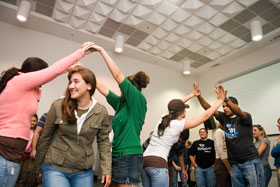  |
| HOME | THIS ISSUE | CALENDAR | GRANTS | BACK ISSUES | < BACK | NEXT > |
Gen ed class learning America’s history through folk musicby Elizabeth Omara-Otunnu - October 9, 2006 |
||||
| Mary Ellen Junda's general education class is rambunctious. She planned it that way. She wants her students to learn about America's cultural traditions through singing American folk songs. And dancing. And clapping. Even shouting. "In order to understand music," says Junda, "you make it." Junda, a professor of music with a background in choral conducting and folk music, usually teaches music education majors. But when the Provost's competition for the development of general education courses was announced, she jumped at the opportunity. "Sing and Shout! The History of America in Song," a three-credit course offered for the first time this semester, features folk songs from a variety of cultures - Anglo American, African American, Native American, Irish American, and Hispanic American. The songs date from colonial times through the early 20th century. Students are learning that folk music is music of a people and gives voice to those who may not otherwise be heard, including women and other marginalized populations, says Junda. They also are beginning to understand that a musical style has an inherent social significance which gave birth to and is articulated by that particular style. The purpose of singing this music, she adds, is for students not only to experience the aesthetic quality of the songs, but also to acquire a deeper understanding of the people of the past. Most music classes, says Junda, are either purely academic, or oriented toward a polished performance at the end. Hoping to depart from these traditional models, Junda sought help from the Institute for Teaching and Learning. During the past year, instructional designer Desmond McCaffrey worked with her to hone her objectives, develop specific assignments, and design ways to measure what the students have learned. "Our role is to support faculty - if they choose to work with us - to try out new things in terms of pedagogy and technology," he says. McCaffrey helped Junda incorporate music and video into PowerPoint, as well as using WebCT for electronic course reserve, listening assignments, rubrics and syllabi, and online tests. The course includes reading and listening and songs to memorize, as well as class participation and three projects. No previous experience is required, but all those who take the course have to sing. Freshman Diana Chouinard is one of about a dozen students in the class who hadn't sung before. "I was extremely nervous at first," Chouinard says, "but as we worked on our own songs, I became more confident." Junda admires these students. "Trying something new is part of what college is about," she says. She is pleased that students in the class are beginning to think about the power of music to communicate ideas.
"Most students know of music as entertainment," she says. "They may not be aware of music that has strong cultural ties and defines people." Chouinard says she has learned a lot from the songs the class has covered. "A lot of them have a message," she says. "They really teach you something from that era." In addition to assessing students' knowledge of course content, Junda will assess their performance: each will record himself or herself singing in class, using a digital recorder. Students will create individual projects on songs they research, including the history and cultural context of the songs, recordings of variants, and the students' individual performances. Last week's project required the students to work in small groups to create their own song about current topics, in the style of a broadside ballad. "The students are not just reading about songs," says McCaffrey. "In order to create their own, there's a synthesis that needs to occur." One group created a ballad to the tune of Froggy Went a-Courting about the lack of privacy on Facebook - the online social network for college students. Another group wrote a song about sex on campus, and the risks of pregnancy and STDs. The groups then had to perform their compositions. Today's class explores children's songs and how singing games evolved into play-parties for young adults. While the students catch their breath, Junda talks about the history of the play party and how it was a means for young people to meet and socialize from the mid-1800s through the 1940s. Play parties were especially prevalent in the Midwest and the South, she says, where some religious groups forbade dancing. "Jingle at the Window" and "Skip to my Lou" were among the games young people used to play at parties. "They didn't have iPods, TVs, or stereos," Junda reminds the class. "This is the way people met and played." Kristin Deming, a freshman majoring in music, says the class gives her a welcome break from straight lecture classes. "You're more involved," she says. "It's fun and you learn a lot." Junda is pleased with how her students are doing. "They're really invested in the class," she says. Next week the class will compare African-American versions of some of the songs they've already learned. Junda hopes that as the course progresses and they explore different styles of music, the students will begin to understand more about the impact of prejudice, and develop an awareness of what it means to be excluded from the mainstream.
|
| ADVANCE HOME UCONN HOME |

